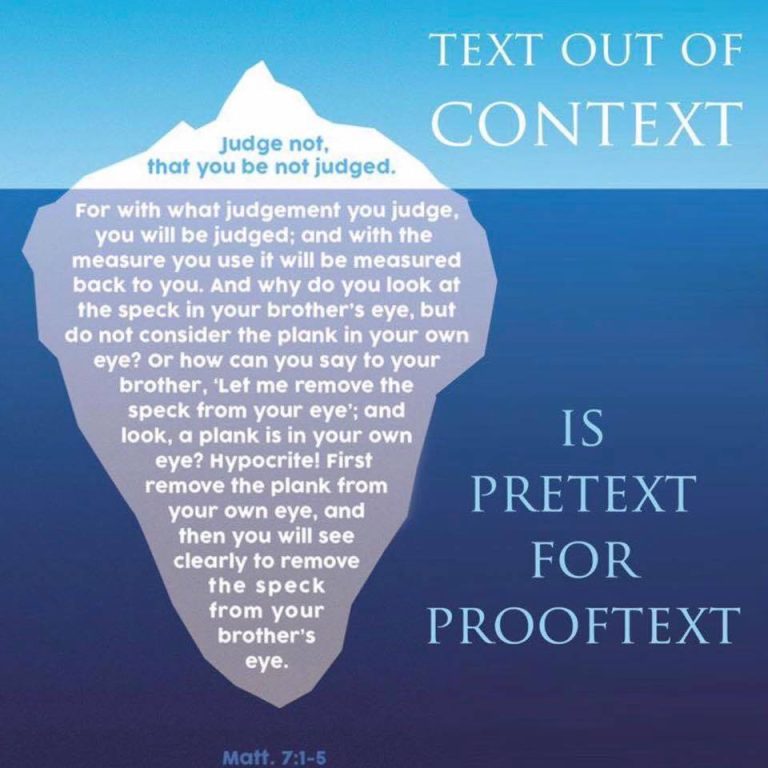How Do the Savior’s Teachings Help Me Make Righteous Judgments?
This lesson, like many lessons Come Follow Me, Young Women, requires a choice. Is your lesson going to be based on the lesson title/topic or on the scriptures listed for the lesson? This is a necessary choice because the lesson title/topic often do not align with the scriptures assigned to the lesson.
The title/doctrinal topic of this lesson is “How Do the Savior’s Teachings Help Me Make Righteous Judgments?” The lesson title contains the word ‘judgments’; the scripture passage assigned to the lesson contains the word ‘judge’ as well as the word ‘righteous’ in the JST version, but that is the extent of the similarity between the lesson title and the scripture reference.
The lesson suggests that Matthew 7:1-2 is about Jesus telling us to make righteous judgements but that is a proof-texted use of those verses. Considered in context, the point of the paragraph consisting of Matthew 7:1-5 is Jesus directing us to take inventory of ourselves; to look inward; be aware of our own ‘beams’. The entire sequence of the Sermon on the Mount is instruction about developing characteristics of the type of person He asks us to become. The ability to be aware of the darker parts of ourselves – our beams – is necessary for growth. In psychology this is often referred to as shadow work; the unconscious part of ourselves that does not align with the ideal version of ourselves. It has nothing to do with judgments either of people or evaluating a situation to make a choice.
So, consider what your young women need and then choose:
- A class based on the title/doctrinal topic of the lesson
- A class based on the scriptures assigned to the lesson
If you choose a class based on the title/doctrinal topic of the lesson:
Teens do need guidance to help them navigate the myriad types of circumstances and situations they encounter because most teens are in a stage of developing values – their own set of principles or standards of behavior. Explain to the class that values direct our path. If you feel comfortable, have the students complete a value sorting activity. Be sure to inform parents of this beforehand since it is outside of the lesson/church/scripture resources.
Jesus’ teachings and actions show that He values people, loving others, and setting boundaries. There is so much to digest that I turned to a letter from Paul to the people living in Philippi, what was a city in north-eastern Greece, to make this topic fit into the time constraints of a young women lesson. In this letter, Paul provides values that he encourages the people to use when choosing where to focus their thoughts. Near the end of the letter he writes:
Finally, brethren, whatsoever things are true, whatsoever things are honest, whatsoever things are just, whatsoever things are pure, whatsoever things are lovely, whatsoever things are of good report; if there be any virtue, and if there be any praise, think on these things.
This part of the letter is now Philippians 4:8. Read together as a class. Then ask the class what types of situations they typically encounter in a day. It could be figuring out friendships, activities online, how to use their time, whether or not to keep commitments, show up to school or work on time, or choosing what types of books/movies/music/activities/behavior in which to engage. Ask the class what choices challenge them? When do they feel uncomfortable or unsure of what to do? Class members can help each other by brainstorming how to use the values listed in the scripture as guides or measurements to help them make choices about the challenges and choices they face.
Conclude class with a reminder that figuring out how to live in a way so that our behavior matches our values takes practice. We won’t always get it right. The important part is to remember the kind of person we are trying to become and that continually trying to make choices in line with our values will help us eventually be the people we want to be.
If you choose a class based on the scriptures assigned to the lesson:
Give the class an overview of the Sermon on the Mount which is given in Matthew chapters 5-7. This overview is clear and concise. It is important to point out that Jesus is speaking to the Jews, people who, like members of The Church of Jesus Christ of Latter-day Saints, view themselves as a covenant chosen people. Jesus gives instructions that give people direction about what kind of people to become. He is teaching them about how to live in a way that will build their character.
Prior to class, select a passage from Matthew chapters 6-7, the scriptures assigned to this lesson, that you think or feel is most needed by your class. Read this post for how to use pilcrows to guide your passage selection. The rest of the lesson will be based on the passage you selected using the TQE method – thoughts, questions, and epiphanies – to guide the class discussion. A simplified explanation of this method is to:
1 – Read aloud the text passage you selected. You can do this or you can ask someone to read who you know will be able to read in a way that gives the text interest. Keep it short. A paragraph’s quantity of verses works great.
2- Write down thoughts, questions, and epiphanies (TQEs). Depending on the size of your group, you may choose to do this all together or split into smaller groups.
3-Write the TQEs on the board. As a group, rewrite as necessary to combine similar TQEs or to clarify obscure TQEs. There is a chance the young women will not be used to doing the work of asking questions and sharing thoughts and epiphanies in church. Be patient! It may take a few lessons. In the meantime, you can help them create TQEs with these sentence stems, courtesy of this post: What did you like? Dislike? What surprised you? What imagery interested you? What questions do you have? What symbols or allusions did you find? For a more detailed explanation of this method, as well as additional sentence stems, see here.
Typically, once a class adjusts to this format, time flies quickly. It is a beautiful thing to see teenagers delving deeply into scriptures.
A few items to note:
- While this lesson only includes Matthew 6-7, the Sermon on the Mount begins in Matthew 5. See this post, “Be Perfect: It’s About Love”, for a breakdown of the command to be perfect in Matthew 5:48.
- A few items to keep in mind about these chapters of scripture. The Come, Follow Me lesson for Matthew 5 describes the Beatitudes as the way to “eternal happiness.” There are a few problems I see with this interpretation. First, ‘eternal’ is nowhere in this section of scripture. That seems to be the addition of the CFM curriculum writers. I also can’t find where Jesus says that the personal development instructions of the Beatitudes are about happiness. Teaching youth that doing ‘X’ action = eternal happiness sets them up for potential shame, mental health illness, and faith crisis when their lived experiences prove that equation false.
- This website by the church but directed towards people who are not members, does a bit better than the CFM manual with its treatment of the Beatitudes. It describes them as eight lessons learned from the Beatitudes; blessings that come when we develop the traits described in these passages. Yes! It is about character development. Thinking of blessings as items dispensed from a machine doesn’t work but thinking about blessings as opportunities to grow in our development does fit the purpose of this text. For more in-depth discussion about a different way to think about blessings, see this podcast: What About Blessings?
Whether you choose a lesson based on the doctrinal topic or a lesson based on the assigned scriptures, remember you’ve got this. Be a gardener, meaning let go of the outcome to allow everyone in the class space to grow.
Image Credit: https://restlesspilgrim.net/blog/2017/06/03/scriptural-iceberg/
Note: This lesson plan was originally written in 2023 as a Young Women lesson: How Do the Savior’s Teachings Help Me Make Righteous Judgments?






3 Responses
So interesting to have that chasm between the title and the scripture contents.
This is great thank you. Appreciate that you gave steps for both approaches to be covered in a healthy and constructive way.
I did the value sorting activity with my kids today. Thanks so much for the idea! It was fun to do as a family